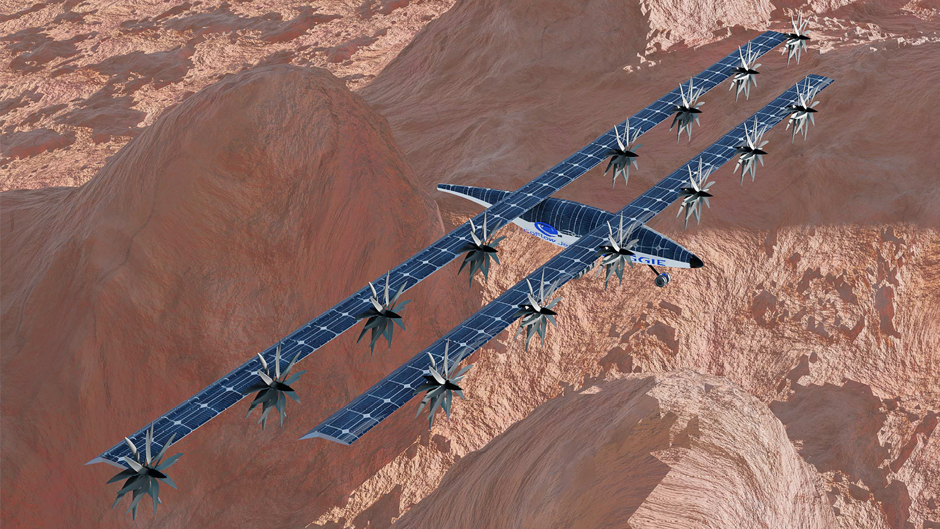Newswise — Rovers have roamed its alien terrain, scooping up rock samples and searching for signs of microbial life in basins once awash with water.
But in the nearly 30 years that NASA has been sending small robotic vehicles to Mars—the space agency’s Jet Propulsion Laboratory has operated five rovers on the red planet since 1997—the probes, inching along at a turtle-like pace, have explored only a small portion of the dusty, cold, desert world.
Now, a University of Miami College of Engineering researcher has designed a new Mars explorer that will be faster and more advanced than any other that has ever probed the planet.
GeCheng Zha’s Mars Aerial Ground and Global Intelligent Explorer, or MAGGIE, is not a land rover at all, but a solar-powered, remote-controlled electric fixed-wing airplane that will soar 3,280 feet in the air, reach a top speed of 135 miles per hour, and take off and land vertically, deploying a suite of sophisticated scientific instruments that could help solve some of the mysteries of Mars.
Science fiction? Make-believe? Far from it.
MAGGIE, which would have solar panels mounted atop its 26-foot wingspan, is closer to reality than not. Zha is perfecting electric vertical take-off and landing (eVTOL) technology that would minimize power consumption by generating lift from the innovative aircraft’s wings and propellers.
“It’s deflected slipstream technology enabled by a co-flow jet airfoil, and a series of micro-compressors embedded into the wings is the key to its success,” said Zha, a professor of aerospace engineering and director of the Aerodynamics and Computational Fluid Dynamics Lab at the College of Engineering. “Those micro-compressors suck in, pressurize, and then expel air to achieve ultra-high lift with virtually stall-free operation. The micro-compressors also work in tandem with a propulsion system to create thrust.”
He has tested a prototype of the wing at Virginia-based Advanced Aircraft Company and at NASA.. “It has performed exceptionally well,” said Zha, noting that the wing will help MAGGIE achieve lift far superior to conventional aircraft on Earth. That greater lift coefficient, he explained, will allow the aircraft to overcome the thin atmosphere on Mars as well as its significantly lower gravity, which is one-third that of Earth’s.
The aircraft wouldn’t fly to Mars, but would hitch a ride aboard a powerful rocket, much like the Perseverance rover rode atop an Atlas rocket that blasted off from Kennedy Space Center in Florida on July 30, 2020.
Once deployed, MAGGIE would survey the entire landscape of the red planet, traveling more than 100 miles on a full battery charge and landing in certain areas to conduct atmospheric and geophysical experiments. Among its potential scientific missions: a study of the origin of the Martian core dynamo from the weak magnetic fields found in large impact basins, an investigation of the source of methane signals detected in the planet’s Gale crater, and mapping of subsurface water ice in the mid-latitudes, where it has been observed from orbit.
Ingenuity, a small autonomous helicopter transported to the surface of Mars while attached to the belly of Perseverance, which landed on the red planet nearly seven months after it left Earth, inspired Zha to come up with the idea for MAGGIE.
The first aircraft to fly on Mars, Ingenuity was originally designed to perform up to five experimental test flights over 30 days. But the little helicopter that could exceeded expectations, making 72 flights over three years and flying more than 14 times farther than planned before a damaged rotor ended its mission.
Ingenuity covered only about 11 miles during its three years of operation. MAGGIE, according to Zha, would cover nearly 10,000 miles over the course of a Martian year—687 days.
“We still must do a lot more testing, specifically under simulated Mars-like conditions. So, a prototype of a full-scale aircraft is still a long way in the future,” Zha said.
Phase I funding from the NASA Innovative Advanced Concepts Program will allow Zha to continue developing MAGGIE.
“But our goal is to make history—the first fixed-wing aircraft to fly on the red planet,” the researcher said. “Even though it is more of a concept right now, we’re excited about the aircraft’s potential to expand humanity’s ability to explore Mars.”

